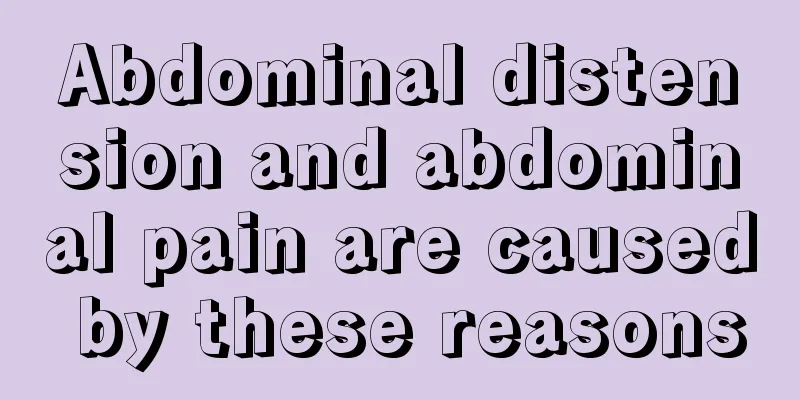Abdominal distension and abdominal pain are caused by these reasons

|
Abdominal distension and abdominal pain are common diseases nowadays. Abdominal distension and abdominal pain will not only cause stomach pain, but also affect multiple organs of the body. Patients with abdominal distension and abdominal pain should understand the specific factors in their daily lives. They may consider poor diet, eating raw and cold food, excessive dieting, and irregular meals to cause abdominal distension and abdominal pain. In addition, pathological factors cannot be ruled out, so the cause should be clarified in time and the appropriate method should be chosen for treatment and diagnosis. Pathological etiology 1. Causes of acute abdominal pain (1) Diseases of abdominal organs: ① Acute inflammation of abdominal organs: acute gastroenteritis, acute corrosive gastritis, acute cholecystitis, acute pancreatitis, acute appendicitis, acute cholangitis, etc. ② Perforation or rupture of abdominal organs: perforation of gastric and duodenal ulcers, perforation of typhoid intestinal organs, rupture of liver, rupture of spleen, rupture of kidney, rupture of ectopic pregnancy, rupture of ovary, etc. ③ Obstruction or expansion of abdominal organs: gastric mucosal prolapse, acute intestinal obstruction, inguinal hernia, intussusception, biliary ascariasis, cholelithiasis, kidney and ureteral stones, etc. ④ Torsion of abdominal organs: acute gastric torsion, ovarian cyst torsion, omentum torsion, intestinal torsion, etc. ⑤ Intra-abdominal vascular obstruction: acute obstruction of the mesenteric artery, acute portal vein thrombosis, dissecting abdominal aortic aneurysm, etc. (2) Abdominal wall diseases: abdominal wall contusion, abdominal wall abscess and abdominal wall herpes zoster, etc. (3) Chest diseases: acute myocardial infarction, acute pericarditis, angina pectoris, pneumonia and pulmonary infarction, etc. (4) Systemic diseases and others: rheumatic fever, uremia, acute lead poisoning, porphyria, abdominal allergic purpura, abdominal epilepsy, etc. 2. Causes of chronic abdominal pain (1) Diseases of abdominal organs: ① Chronic inflammation: reflux esophagitis, chronic gastritis, chronic cholecystitis, chronic pancreatitis, tuberculous peritonitis, inflammatory bowel disease, etc. ② Gastric, duodenal ulcer and gastrinoma, etc. ③Torsion or obstruction of abdominal organs: chronic gastrointestinal torsion, intestinal adhesions, omental adhesion syndrome, etc. ④ Increased organ capsule tension: liver congestion, hepatitis, liver abscess, liver cancer, splenomegaly, etc. ⑤ Gastrointestinal motility disorders: gastroparesis, functional dyspepsia, hepatic flexure and splenic flexure syndrome. |
<<: What to eat to cleanse the intestines and promote bowel movements
>>: What methods can be used to regulate insufficient gastric motility?
Recommend
Advantages and disadvantages of silk mist eyebrows
Women's eyebrows have different shapes depend...
How much does a nasopharyngeal endoscopy cost for nasopharyngeal carcinoma
When diagnosing nasopharyngeal cancer, more exami...
How to remove ink from clothes more effectively
If you are not careful, it is easy to get ink on ...
Experts say drinking more water is an effective way to prevent bladder cancer
Talking about bladder cancer makes people think o...
What causes swollen finger joints?
Finger joints are very flexible and are the key t...
The efficacy and function of green wheatgrass juice
Many people may not know that wheatgrass juice is...
What diseases are associated with expiratory dyspnea
The happiest thing in life is to have a healthy b...
Does it hurt to pull out a toenail?
Many people will ask whether it hurts to pull out...
Histopathological grading of breast cancer
Breast cancer is a highly heterogeneous disease. ...
Is it contagious to take care of a colon cancer patient?
Is it contagious to take care of a colon cancer p...
What are the symptoms of sunken eyeball due to orbital fracture
Orbital fractures can easily cause sunken eyeball...
The high-risk groups for rectal cancer are mainly the following categories
We must do a good job in preventing rectal cancer...
Can ceftriaxone treat headaches?
Headache is a common disease that bothers us. Whe...
What are the methods for checking gastric cancer? There are several methods
Clinically, the most commonly used examination me...
What are the main symptoms of cervical cancer
What are the main symptoms of cervical cancer? I ...









